By Des McKibbin & Keara McKay
As temperatures plummetted towards the end of November 2017, forecasters began to predict the coldest December in seven years. Meteorologists are suggesting winter 2017/18 could be colder than normal with the return of an atmospheric phenomenon known as La Niña. La Niña events tend to occur every five years and increase the chance of cold weather, as was the case in winter 2010 when much of the country was covered in snow. Ice and snow on roads and footpaths has the potential to cause a number of problems on the road network, from a simple slip and bump to a major accident causing injury or even death. With snow and ice making a return in recent days, this blog article looks at the steps taken by government to deal with ice and snow to minimise the risk they pose here in Northern Ireland.
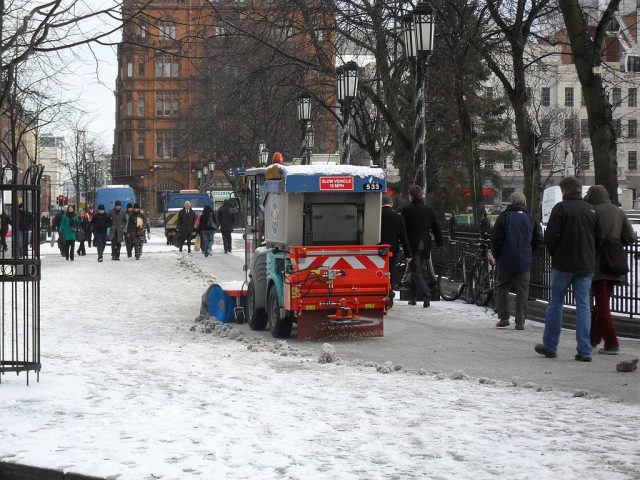
The Department for Infrastructure’s (DfI) Roads Division is responsible for the maintenance of over 25,000km of public roads together with about 9,700km of footways, 5,800 bridges, 290,000 street lights and 367 public car parks. One of the key objectives for DfI Roads Division is to: manage, maintain and improve the transport network to keep it safe, efficient, reliable and sustainable. As part of this it will routinely grit roads between 1st October and 30th April each year, during what is known as the ‘winter service’ season.
DfI has a duty to remove obstructions in the road caused by accumulations of snow under Article 10 of the Roads (Northern Ireland) Order 1993. However, although the Department commits a substantial resource to the gritting of roads, around £6.2 million for 2013/14, it is not required to do so. Under Article 9 of the Order, the DfI has discretionary powers to take preventative measures, including gritting, so that ice and snow do not interfere with the safe passage of persons and vehicles using a road. It can do this itself, arrange for contractors to do it, or leave materials for members of the public to use.
Winter service
In a normal winter, DfI Roads Division’s ‘winter service’ is a major logistical undertaking that involves around 300 staff and a fleet of 130 ‘gritters’, on call every day to salt the busiest parts of the road network. Almost 7,000 km (4,300 miles) of roads are salted which is 28% of the length of the road network and salting it costs £4.5M in an average winter.
How does DfI choose where to grit?
Historically, winter service policy and road salting schedules had been developed on a mostly informal basis, mainly by drawing on the knowledge of divisional engineers and in response to local political pressures. However, in July 1991, Roads Service set up a Standing Working Group (SWG) to review winter service policy and procedures and to develop objective criteria for the salting of roads which would:
- Introduce consistency of decision-making and parity of treatment throughout Northern Ireland; and
- Maximise the benefit by targeting roads which carried the heavier traffic flows.
The most significant outcome of the review was the establishment of criteria that were to be applied to determine which roads within Northern Ireland would be salted. This would form the basis for the development of a revised salted road network. It was concluded that treating roads carrying fewer than 1,000 vehicles per day would not be cost-effective. Therefore, DfI Roads Division focuses its resources on the busiest 28% of the total road network, which carries around 80% of traffic:
- Motorways and Trunk Roads;
- Main through routes carrying more than 1,500 vehicles per day;
- Other busy through routes carrying more than 1,000 vehicles per day may be included if there are difficult circumstances, such as steep hills;
- Special allowance is made for school and other buses by a weighting factor, e.g. a 40 seater bus is counted as 40 vehicles;
- Links to small settlements, (100 dwellings or more) via the shortest route to the main salted road;
- On more lightly trafficked roads 4,800 salt bins and almost 50,000 grit piles are provided for use by the public on a self-help basis;
- Special arrangements are in place for rural schools that face particular difficulties;
- Salting may also be undertaken in urgent situations such as to provide access for the emergency services, unforeseen occurrences such as funerals or to help get fuel or feed stocks to farmers; and
- Approximately 4,800 salt bins and almost 50,000 grit piles are provided on public roads for use by the public on a self-help basis.
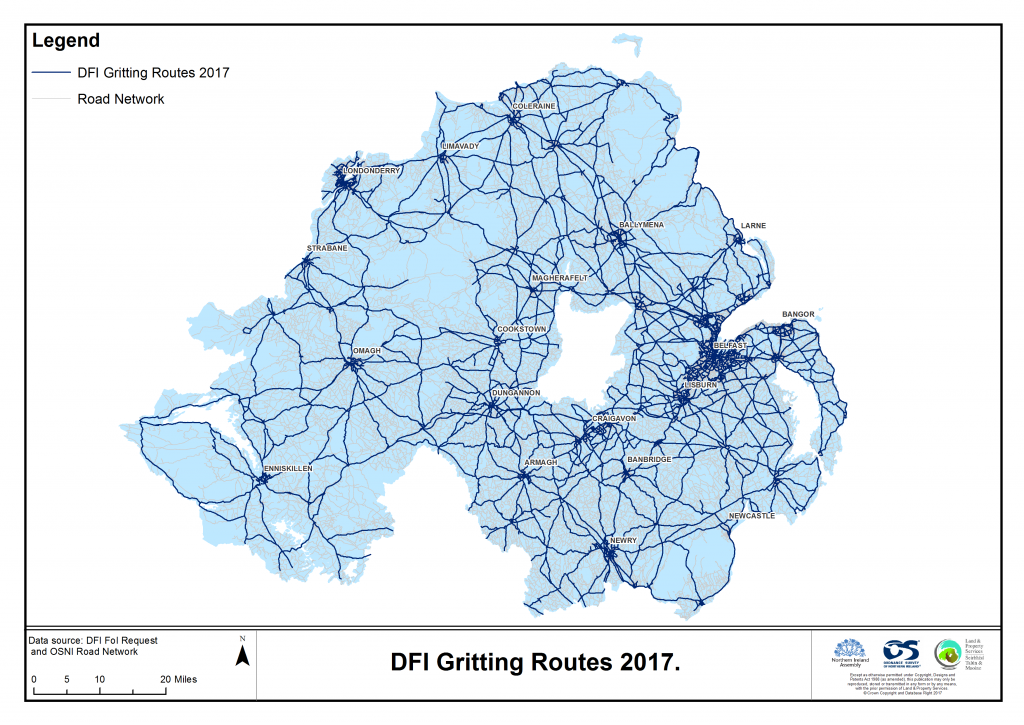
When does DfI not grit?
There are conditions during which DfI will not grit roads, these include:
- When heavy rain is occurring, due to the risk of salt wash-off;
- On dry roads where frost is not predicted to form; and
- In the middle of the night and on roads with fewer vehicles, as traffic is required to turn salt into de-icing solution.
The most recent review of winter service took place in June 2013. The review concluded that DfI has developed and implemented a robust, risk-based rationale for determining the extent of the road network that is subject to routine precautionary salting during the winter months.
Clearing ice and snow from footways
DfI Roads Division does not routinely salt footpaths but, where resources permit, it has agreed to work with local councils during prolonged periods of snow and ice to clear footways in busy town centres. This had been an area of contention in previous winters, largely due to the fact that there is no statutory duty on either the DfI or local councils to clear footpaths while there were questions around liability. It finally came to a head during the big freeze of 2010, prompting the Attorney General for Northern Ireland to advise that if snow/ice was dealt with carefully, “you are unlikely to be held liable”.
Snow, ice and road safety
Over the period 2012-16 snow, frost and/or ice have been noted as a ‘contributory factor’ in 10 fatal collisions and 68 serious collisions (see MAP 2 and MAP 4). By way of comparison, wet and damp conditions (see MAP 3, below) have been noted as a ‘contributory factor’ in 119 fatal collisions and 932 serious collisions. This relatively low number of accidents for which snow, ice and frost have been a factor could be an indication of many things including fewer people driving during these conditions, people driving with more care, the effectiveness of the gritting programme, and the number of days when snow, ice or frost were present during these years.
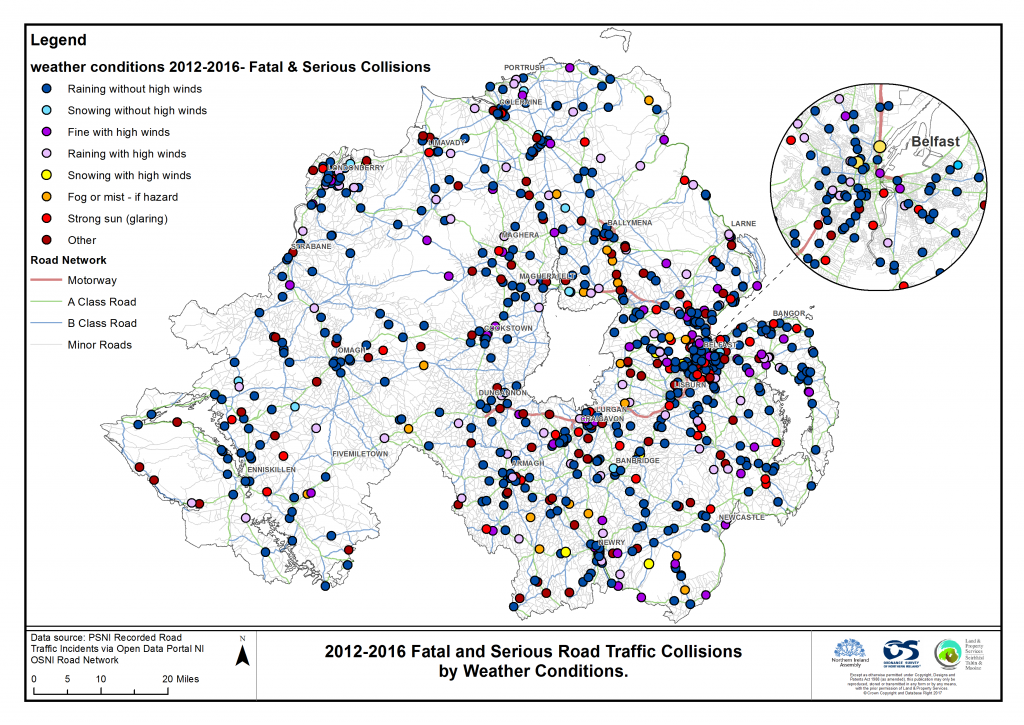
The area shown in red in Map 3 is a ward called Stonyford. It has had 19 road traffic collisions (RTCs) due to snow, ice and frost between 2012 and 2016. That includes all collisions, slight, serious and fatal. This area includes Rock Road and Hannahstown Road. It is a rural, hilly area, with quarries and sits between Black Mountain and White Mountain.
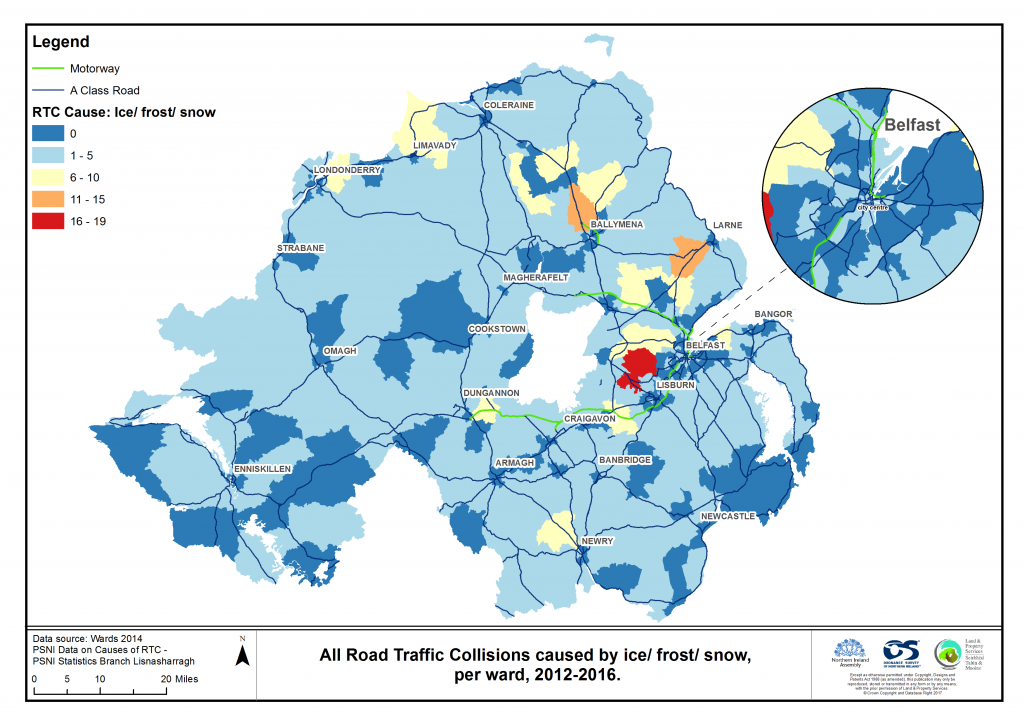
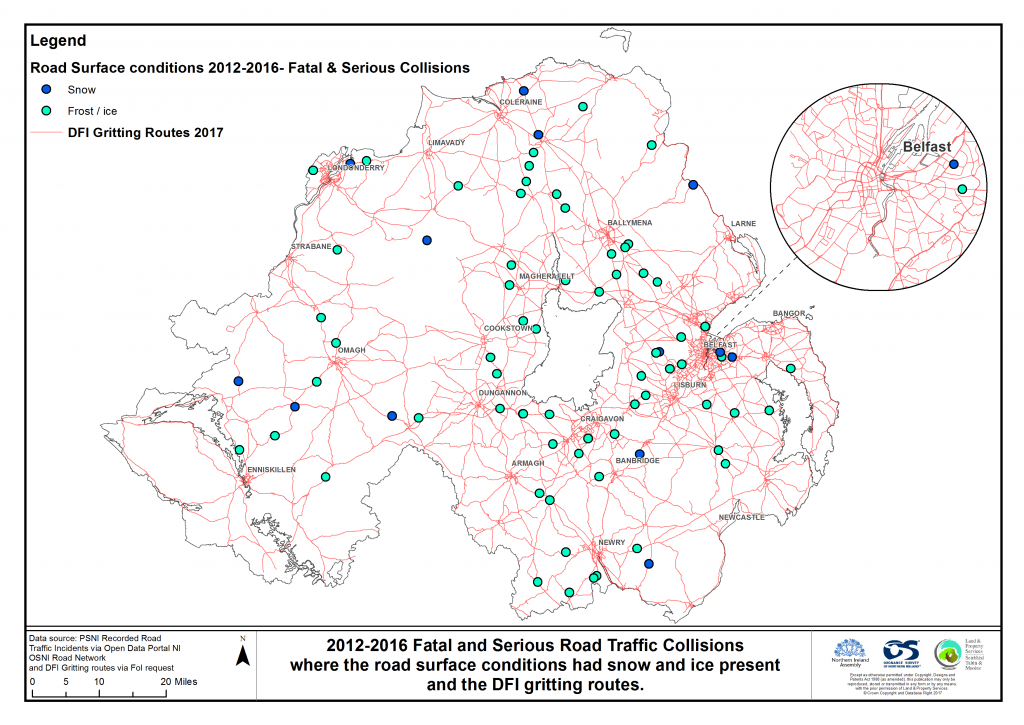
Climatic conditions
The Met Office observes that Northern Ireland has relatively mild winters. The number of days of snowfall and snow cover varies enormously from year to year. At many places in the last 50 years it has ranged from none at all in several winters to in excess of 30 days during the winters of 1962/63 and 1981/82. The same is true for frost days in Northern Ireland. These vary widely depending on the location – with the main controls being distance from the sea and altitude:
- An ‘air frost’ occurs when the temperature at 1.25 metres above the ground falls below 0°C;
- Incidence of a ‘ground frost’ refers to a temperature below 0°C measured on a grass surface;
- Sites along the coast typically have fewer than 20 days of air frost each year;
- Inland, the number increases with altitude to over 55 days in the highest upland areas;
- Ground frost occurs on average on fewer than 80 days each year on the coast; and
- Over 115 days in the highest upland areas and the most frost-prone lowland locations, with a similar distribution to air frost.

